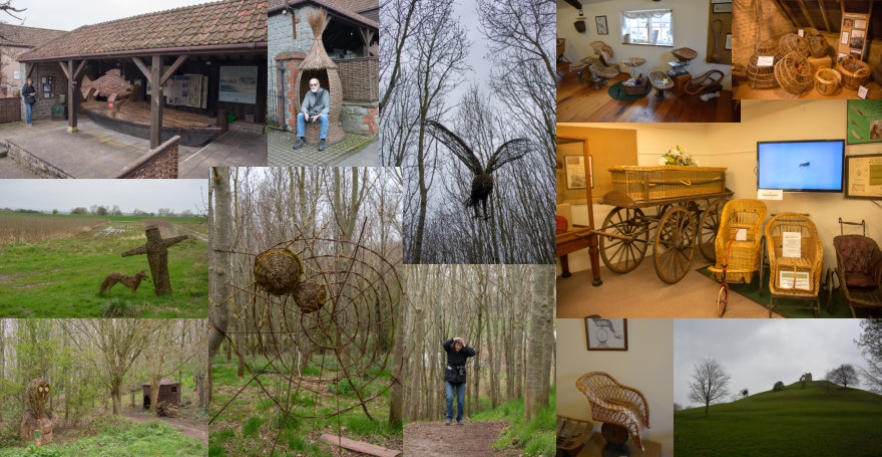Coates English Willow
Much to my chagrin, Sheila insisted on visiting Coates English Willow to see basket weaving. It was yet further west, embedded in an even more obscure maze of partially flooded, muddy, single-lane roads and tracks. A family operation for 200 years, Coates have been planting, harvesting, processing, and hand weaving withies (willow branches) into the most amazing array of wicker items from individual packing baskets for WW1 artillery shells, balloon baskets, aeroplane seats, chairs, tables, serving trays, wheelchairs, baby and doll carriages, carts (horse, pony, and push), hampers, hand baskets, specialty weighing baskets, fish and bird traps, the frame for the Queen’s Guards Bear Skin hats, coffins, hurdles, and lawn ornaments… We attempted to walk around the withy fields but the wet, muddy ground defeated our shoes. We did manage a short walk through the woods where woven animal figures lurked along the trail. Back at the visitor centre, surrounded by an assortment of willow items, we watched a fascinating video describing the history and techniques of growing, harvesting, treating, and weaving the willow and the museum held examples of historical woven willow items. Coates English Willow survives today, over 50% of their business comes from the production of high quality drawing charcoal, but they also produce standard items like hurdles, trays and baskets, as well as bespoke (custom made) items (many for period movies). I should have had more faith, it was a fascinating and delightful outing.





A Sense of Place: Travel, Photography, and Photo-art
by David E. Moon

© David E. Moon, 2018 All rights reserved


Coates English Willow
Much to my chagrin, Sheila insisted on visiting Coates English Willow to see basket weaving. It was yet further west, embedded in an even more obscure maze of partially flooded, muddy, single- lane roads and tracks. A family operation for 200 years, Coates have been planting, harvesting, processing, and hand weaving withies (willow branches) into the most amazing array of wicker items from individual packing baskets for WW1 artillery shells, balloon baskets, aeroplane seats, chairs, tables, serving trays, wheelchairs, baby and doll carriages, carts (horse, pony, and push), hampers, hand baskets, specialty weighing baskets, fish and bird traps, the frame for the Queen’s Guards Bear Skin hats, coffins, hurdles, and lawn ornaments… We attempted to walk around the withy fields but the wet, muddy ground defeated our shoes. We did manage a short walk through the woods where woven animal figures lurked along the trail. Back at the visitor centre, surrounded by an assortment of willow items, we watched a fascinating video describing the history and techniques of growing, harvesting, treating, and weaving the willow and the museum held examples of historical woven willow items. Coates English Willow survives today, over 50% of their business comes from the production of high quality drawing charcoal, but they also produce standard items like hurdles, trays and baskets, as well as bespoke (custom made) items (many for period movies). I should have had more faith, it was a fascinating and delightful outing.



A Sense of Place: Travel, Photography, and Photo-art

© David E. Moon, 2014 All rights reserved






















